- Capture more stones than your opponent
- If no player has captured any stones after the maximum number of turns is reached, the player that has played more stones wins (to prevent a draw if a player passes in every move)
A higher resolution is required to access the IDE
- 13
Learning Opportunities
This puzzle can be solved using the following concepts. Practice using these concepts and improve your skills.
Statement
This is a slight modification of the board game Go
Click here for an introduction into the rules of Go.
Click here for the Referee code
Click here for an introduction into the rules of Go.
Click here for the Referee code
Rules
Atari Go is a modification of the classical board game Go, that is often used to teach new players the rules of Go.
The rules are basically the same as the Go rules with some modifications to make the game a bit easier:
While playing, both players place one of their stones (per turn) on a free position on the field. The stones are not moved after they are placed. You can only add new stones.
The goal of the game is to capture the stones of your opponent. This can be done by surrounding the stones (or groups) of your opponent with your stones. If a stone or group has no free fields beneath it, it is captured and removed from the board (see example 2).
If a stone is surrounded by other stones of the same color this stone is not captured, but all stones that are directly touching each other form a group. This group shares it's free fields. So a group of stones is often stronger and more difficult to capture than a single stone (see example 1).
Beside these simple rules there are a view more rules, on where stones can be placed and where not.
The rules are basically the same as the Go rules with some modifications to make the game a bit easier:
- You don't gain points by occupying fields
- The only way to gain points is to capture the stones of your opponent
- The game does not end after both players have passed (the game ends after
80 turns) - All other rules stay the same as in the game of Go
Go Rules
A game of Go is usually played on a board of 19x19 fields. In the first leagues a board of 9x9 or 13x13 fields is used, but in the later leagues a 19x19 board is used.While playing, both players place one of their stones (per turn) on a free position on the field. The stones are not moved after they are placed. You can only add new stones.
The goal of the game is to capture the stones of your opponent. This can be done by surrounding the stones (or groups) of your opponent with your stones. If a stone or group has no free fields beneath it, it is captured and removed from the board (see example 2).
If a stone is surrounded by other stones of the same color this stone is not captured, but all stones that are directly touching each other form a group. This group shares it's free fields. So a group of stones is often stronger and more difficult to capture than a single stone (see example 1).
Beside these simple rules there are a view more rules, on where stones can be placed and where not.
- You can only place a stone on a field where no stone is placed yet
- You can not play a stone that would directly be removed (no suicidal moves). An exception to this rule is that the opponent stones are removed before this rule is applied. So if your stone seems to be directly surrounded by other stones, but it captures and removes at least one of the surrounding stones it can be played (see example 3)
- You can not play a stone that would lead to the same board, like in the last turn when you played a stone. This is called the Ko-Rule (see example 4)
Examples
Example 1 - Groups
In the image below the three white stones form a group. Therefore the two upper stones (that are completely surrounded) are not captured as long as one stone of the group is not completely captured.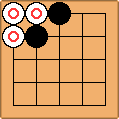
Example 2 - Capturing stones
In the image below the white stone is almost captured. The last free field it has is marked with a red square. The other fields (marked with red crosses) are not directly adjacent to the white stone and are therefore no free fields for the white stone.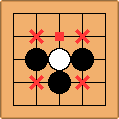
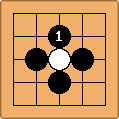
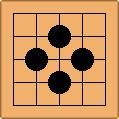
Example 3 - Suicidal moves
In the image below, a white stone that is placed in the middle of the four black stones would have no free fields beneath it and would be directly removed. Therefore a white stone can't be placed in the middle of the black stones in this case.
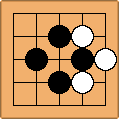
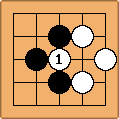
Example 4 - Ko-Rule
In the third example it was shown that in a field, like the one in the image below, a white stone can be placed in the middle of the four black stones...

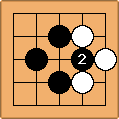
But it would be possible to place a black stone on any other field, let white place a stone too, and then come back to this formation of stones and place the black stone in between the white stones (like in the image above) because now it would no longer lead to the same board like in the first image of this example (there are now two more stones placed somewhere on the board).
Victory Conditions
Loss Conditions
- You send an illegal move
- You don't respond in time or output an unrecognized command
Game Input
Initial input
First line: myColor: B if you are playing the black stones or W if you're playing the white stones.
Next line: boardSize: an integer representing the size of the board
Next line: boardSize: an integer representing the size of the board
Input for one game turn
First line: x y: two integers representing the position of the last stone, that your opponent played ("-1 -1" in the first turn)
Next line: myScore opponentScore: two integers representing your current score and your opponent's current score (the number of captured stones)
Next boardSize lines: line: one line of the current board, whereB marks a black stone, W marks a white stone and . marks an empty field
Next line: myScore opponentScore: two integers representing your current score and your opponent's current score (the number of captured stones)
Next boardSize lines: line: one line of the current board, where
Output
A single line containing: either the x and y coordinates of the next stone you want to play or PASS if you don't want to play a stone (PASS is always a valid move)
Constraints
Response time first turn is ≤
Response time per turn is ≤
The game ends after
A higher resolution is required to access the IDE